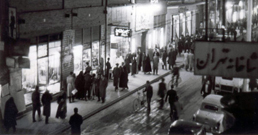Javad Tahami set up one of the earliest photographic studios in
The first Iranian photographer was prince Malek-Ghasem Mirza, but gradually people outside the court took up this trade. Antoine the photographer, Mashallah Khan and Russi Khan are amongst the few.
With the spread of photography, private studios were established and photography became a popular occupation.
One of these photographers is Seyyed Javad Tahami, who established his studio at Amin-Hozour Junction in 1928. After the Second World War, he moved his studio to its present day location of
Baharestan Square
Almost forty years after his death, Dariush Tahami, his son, took over the business. Dariush Tahami says that, he has been preserving his father’s business so that its not forgotten despite the difficulties and the hardship.
He speaks of his father’s life in these words: “My father was born in 1905. In his early childhood, he lost both his parents and went to live with his uncle. After he completed his primary schooling, or Maktab, and due to financial strains he began working. After he had been working for a fabric shop for a year or two he left his job, and started working for a photo studio in
Lalehzar street in
Javad Tahamhi is considered one of
In those days, large wooden cameras were used in ateliers, and photos were being printed on glass. They did not have electricity and photos were printed by means of natural light. Photo studios were scarce in the cities and few people had cameras.
Dariush Tahami says: “As a result of his interest in historical and cultural affairs, my father started compiling a historical collection from his own work, and from the photos that he had purchased from collectors’ archives. Sometimes he had to pay hefty sums for the purchase of these archives. However, my father was determined to complete this collection, and today the numbers of these photos have reached into the thousands. He remained in this business for more than half a century. He passed away in 1983.”
Dariush Tahami describes his own life and his experience in working with his father: “I was born in 1958. I became interested in photography from early childhood and worked for my father periodically. In 1979, I was admitted to the university to pursue my studies in the fields of dramatic arts and film-making.
This period coincided with my father’s severe illness and his deteriorating eye-sight. My father told me: ‘come and work for me. You will not receive any degree, but you will learn a trade.’
After my father’s passing, I decided to take over the business and prevent it from being forgotten. Although at times due to financial constraints we were close to sell the business, but I felt that it is my duty to preserve Tahami’s studio, its memories and stories, for this nation and its people.
From then on, I began to collect and organize the photos, which resulted in the publication of seventeen books. Books of photography such as: Old
You must have seen photos from Tahami’s archives in films and history books. Directors such as Ali Hatami for the making of the TV series “Hezardastan,” Bahram Beizai and Kianoush ‘Ayari, consecutively, for the making of the feature films “Shayad Vaghti Digar” [Maybe Another Time], and “Rouzegare Gharib” [Strange Times] have come to the Tahami Studios. Also many historians have used photos from Tahami’s archives in their books.
These days Dariush Tahami’s young daughter and son are converting the archives’ negatives into digital format. While using “photo-shop” to modify the photos, more than they not thinking about the difficult days when their grandfather printed photos from glass negatives.



